Installation
To install and run SSIS Integration Toolkit for Microsoft Project Server, your system must have the following components installed.
-
A supported SSIS design-time or run-time, which can be one of the following:
- Azure-SSIS Integration Run-time
- SSIS 2022
- SSIS 2019
- SSIS 2017
- SSIS 2016
- SSIS 2014
- SSIS 2012
For SSIS run-time, the installation should be done by using the corresponding SQL Server installation media, and you must select the "Integration Services" component during the installation, as shown below:
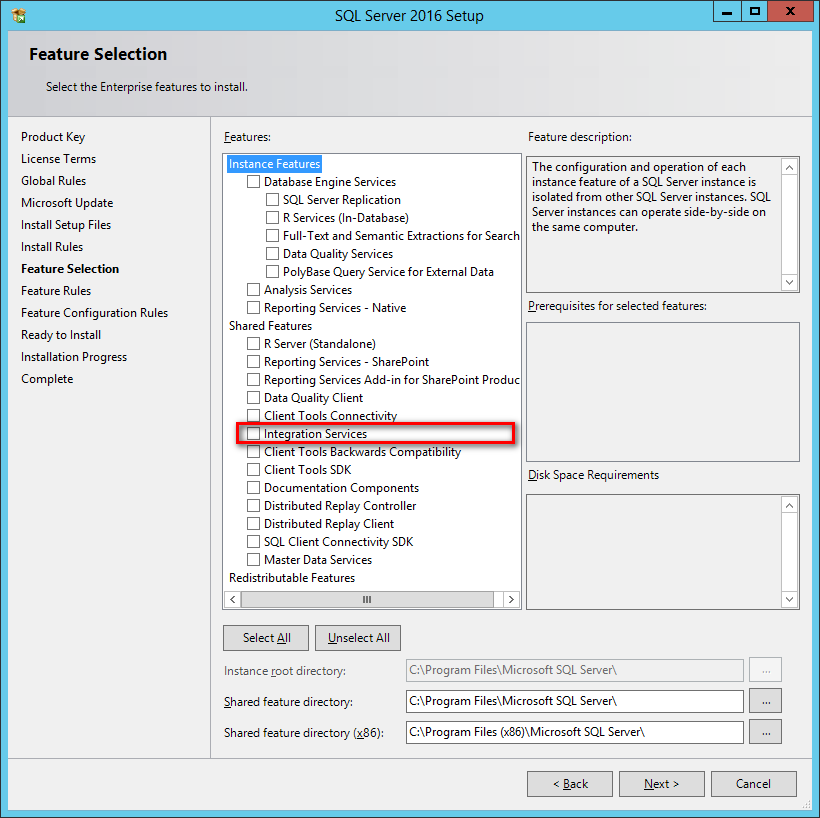
Note that when using SQL Server 2014, a cumulative update is required (a recent service pack, such as one of the following, is preferred) in order to run our software during run-time.
- SQL Server 2014 Service Pack 2: https://www.microsoft.com/download/details.aspx?id=53168
- SQL Server 2014 Service Pack 1: https://www.microsoft.com/download/details.aspx?id=46694
For SSIS design-time, you should be installing the version of SSDT (SQL Server Data Tools) or BIDS (Business Intelligence Development Studio) that aligns with the SQL Server version that you plan to use for your final deployment (the run-time).
Target Server Design Time Azure-SSIS IR Any one of the following: SSIS 2022 Any one of the following: SSIS 2019 Any one of the following: SSIS 2017 Any one of the following: SSIS 2016 Any one of the following: SSIS 2014 Any one of the following: -
SSDT for Visual Studio 2019
- Packages created using SSDT 2019 need to have their project's TargetServerVersion setting set to "SQL Server 2014" in order to work with SSIS 2014.
-
SSDT for Visual Studio 2017
- Packages created using SSDT 2017 need to have their project's TargetServerVersion setting set to "SQL Server 2014" in order to work with SSIS 2014.
-
SSDT for Visual Studio 2015
- Packages created using SSDT 2015 need to have their project's TargetServerVersion setting set to "SQL Server 2014" in order to work with SSIS 2014.
- SSDT-BI for Visual Studio 2013
SSIS 2012 Any one of the following: - SSDT-BI for Visual Studio 2012 (recommended; most reliable)
-
SSDT for Visual Studio 2019 (not recommended due to potential compatibility issues with ISV solutions)
- Packages created using SSDT 2019 need to have their project's TargetServerVersion setting set to "SQL Server 2012" in order to work with SSIS 2012.
-
SSDT for Visual Studio 2017 (not recommended due to potential compatibility issues with ISV solutions)
- Packages created using SSDT 2017 need to have their project's TargetServerVersion setting set to "SQL Server 2012" in order to work with SSIS 2012.
-
SSDT for Visual Studio 2015
- Packages created using SSDT 2015 need to have their project's TargetServerVersion setting set to "SQL Server 2012" in order to work with SSIS 2012.
-
A Windows Operating System
Windows operating system requirement largely depends on the version of SSIS run-time or design-time selected. We don't have any additional requirements in terms of the Windows operating system as long as it satisfies the minimum requirements of SSIS run-time or design-time. The general guideline is the newer the operating system is, the better. In summary, our software should work for the following Windows operating systems.
-
For desktop systems (mostly for development workstations)
- We generally recommend Windows 10, version 1507 or greater.
- Windows 8.1, 8, or 7 should work fine with our software installation which supports most SSDT versions and SQL Server 2016 or below, but we highly recommend you upgrade to Windows 10 because of their support status with Microsoft.
-
For server systems (mostly for run-time deployments)
- We generally recommend Windows Server 2016 or greater (Including Windows Server 2019 and potentially future Windows Server versions).
- Windows Server 2012 or Windows Server 2012 R2 should work fine for SSIS versions up to 2016.
- We generally recommend Windows Server 2016 or greater (Including Windows Server 2019 and potentially future Windows Server versions).
-
For desktop systems (mostly for development workstations)
-
A .NET Framework
- Our software requires the installation of .NET Framework 4.5.2 or above
- For SSIS 2016 or above, .NET Framework 4.6 (or above) is generally a prerequisite, no additional installation is required.
- For SSIS 2014 or lower, you may turn on the .NET Framework feature or install it by downloading it from the Microsoft website.
- For SSIS 2016 or above, .NET Framework 4.6 (or above) is generally a prerequisite, no additional installation is required.
- Our software requires the installation of .NET Framework 4.5.2 or above
When you have confirmed that your system satisfies the above prerequisites, you can navigate to the KingswaySoft website at https://www.kingswaysoft.com to download the installation package.
After you have downloaded the package, you can install the software by following the installation wizard.
Working with the SSIS Toolbox
SSIS Toolbox is the first place that you will be looking for our components to be added to your ETL process during the design time.
If you are working with SSIS 2012 or later, SSIS Toolbox should be automatically available during the design time once you have an SSIS package opened provided that you have our software installed properly. If you do not see the SSIS Toolbox, click either the SSIS Toolbox menu option under the SSIS menu or the SSIS Toolbox icon in the design window's upper right corner, as shown below.
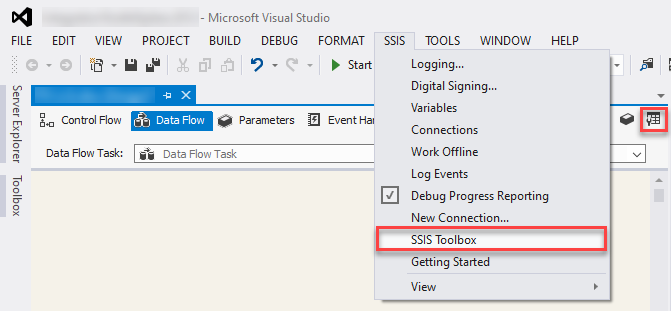
Note: When working with SSIS Toolbox, you need to make sure that you are in the right view in order to see the right components. For instance, if you are looking for a data flow component, you need to make sure that you are in the Data Flow view, not the Control Flow view. Visual Studio would show different components depending on the design view that you are currently working with.
Once the data flow components are available in the SSIS Toolbox, you can start your ETL development by dragging them from the toolbox to the Visual Studio design surface.
Using the Project Server Connection Manager
The Project Server Connection Manager is an SSIS connection manager component that can be used to establish connections with Microsoft Project Server.
To add a Project Server connection to your SSIS package, right-click the Connection Manager area in your Visual Studio project, and choose "New Connection..." from the context menu.
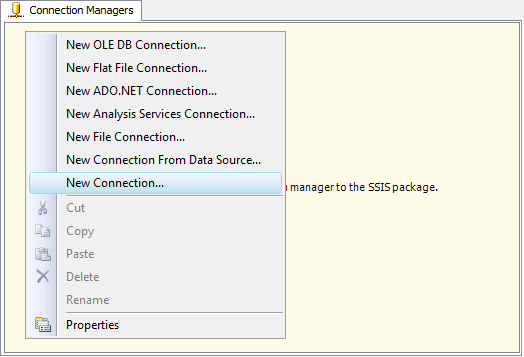
You will be prompted the "Add SSIS Connection Manager" window. Select the "ProjectServer" item to add the new Project Server Connection Manager.
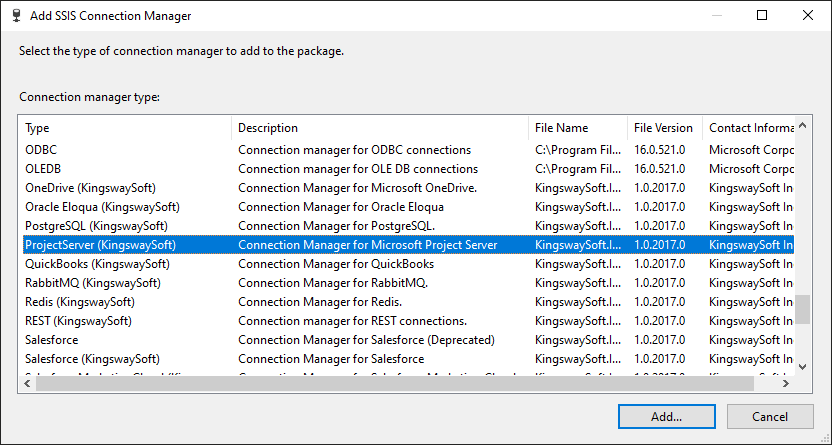
The Project Server Connection Manager contains the following three pages which configure how you want to connect to Project Server:
- General
- Advanced Settings
- More Info
General Page
The General page on the Project Server Connection Manager allows you to specify general settings for the connection.
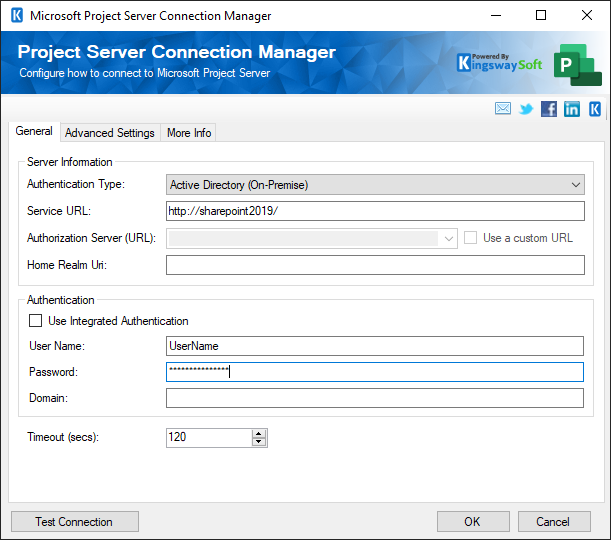
- Server Information
-
- Authentication Type
-
The Authentication Type option allows you to specify the deployment type of your Project Server and the authentication it uses. There are three options available:
- Active Directory (On-Premises)
- Federation (Claim-based Authentication)
- Online Federation (Office 365, Project Server Online)
- Service URL
-
Using the Service URL option, you can provide an alternative Project Server web service URL which you may have set up in a way that's different from the default.
- Authorization Server (URL)
-
Using the Authorization Server (URL) option, you can provide an alternative region-specific base Azure AD authorization server endpoint.
- Home Realm Uri
-
This option applies to the Federation and Online Federation authentication types, and it may only be required for certain federated environments. It’s important to note that the Home Realm Uri option is case-sensitive. In the case that this option is required, it should typically be in the following format.
- Note that the Home Realm Uri option is case-sensitive.
- Authentication
-
- Use Integrated Authentication
-
This checkbox specifies whether you want to use Integration Authentication or provide separate login credentials. This option is only available when using Active Directory (On-Premises) Authentication Type.
- User Name
-
The User Name option allows you to specify the user account that you want to use to connect to Project Server. Depending on how the SharePoint connection is used, the user account needs to have proper privileges in your Project Server system.
- Password
-
The Password option allows you to specify the password for the above user account in order to log in to Project Server.
Note: The Password is not included in the Project Server connection manager's ConnectionString property by default. This is done by design for security reasons. However, you can include it in your ConnectionString if you want to parameterize your connection manager. The format would be Password=myPassword; (make sure you have a semicolon as the last character). It can be anywhere in the ConnectionString.
- Domain
-
The Domain option allows you to specify the domain (e.g. Active Directory) of the above user account.
- Timeout (secs)
-
The Timeout (secs) option allows you to specify a timeout value in seconds for the connection. The default value is 120 seconds.
- Test Connection
-
After all the connection information has been provided, you may click the Test Connection button to test if the connection settings entered are valid.
Advanced Settings Page
The Advanced Settings page on the Project Server Connection Manager allows you to specify some advanced and optional settings for the connection.
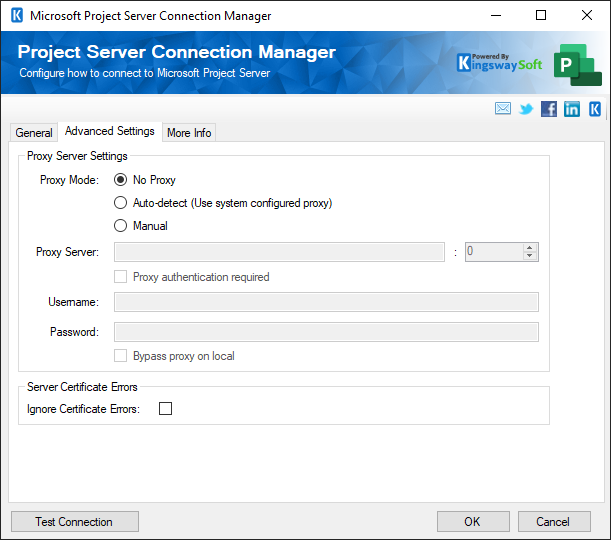
- Proxy Server Settings
-
- Proxy Mode
-
The Proxy Mode option allows you to specify how you want to configure the proxy server setting. There are three options available.
- No Proxy
- Auto-detect (Using system-configured proxy)
- Manual
- Proxy Server
-
Using the Proxy Server option, you can provide a proxy server to connect to Project Server.
- Port
-
The Port option allows you to specify the port number of the proxy server for the connection.
- Username (Proxy Server Authentication)
-
The Username option (under Proxy Server Authentication) allows you to specify the proxy user account.
- Password (Proxy Server Authentication)
-
The Password option (under Proxy Server Authentication) allows you to specify the proxy user's password.
Note: The Proxy Password is not included in the connection manager's ConnectionString property by default. This is by design for security reasons. However, you can include it in your ConnectionString if you want to parameterize your connection manager. The format would be ProxyPassword=myProxyPassword; (make sure you have a semicolon as the last character). It can be anywhere in the ConnectionString.
- Server Certificate Errors
-
- Ignore Certificate Errors
-
This option can be used to ignore those SSL certificate errors when connecting to the target server.
Warning: Enabling the "Ignore Certificate Errors" option is generally NOT recommended, particularly for production instances. Unless there is a strong reason to believe the connection is secure - such as the network communication is only happening in an internal infrastructure, this option should be unchecked for best security.
More Info Page
The More Info page shows some basic information about the toolkit. On this page, you can find the version information of the toolkit.
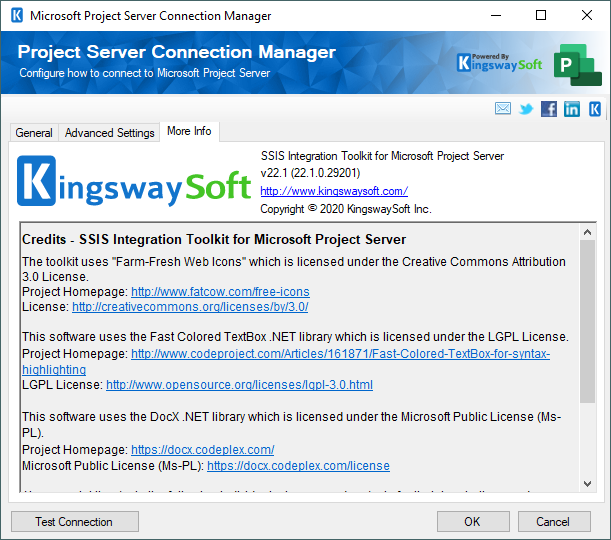
Using the Project Server Source Component
The Project Server Source Component is an SSIS data flow pipeline component that can be used to read/retrieve data from Microsoft Project Server.
The component includes the following two pages to configure how you want to read data from Project Server.
- General
- Columns
General Page
The General page of the Project Server Source Component allows you to specify the general settings of the component.
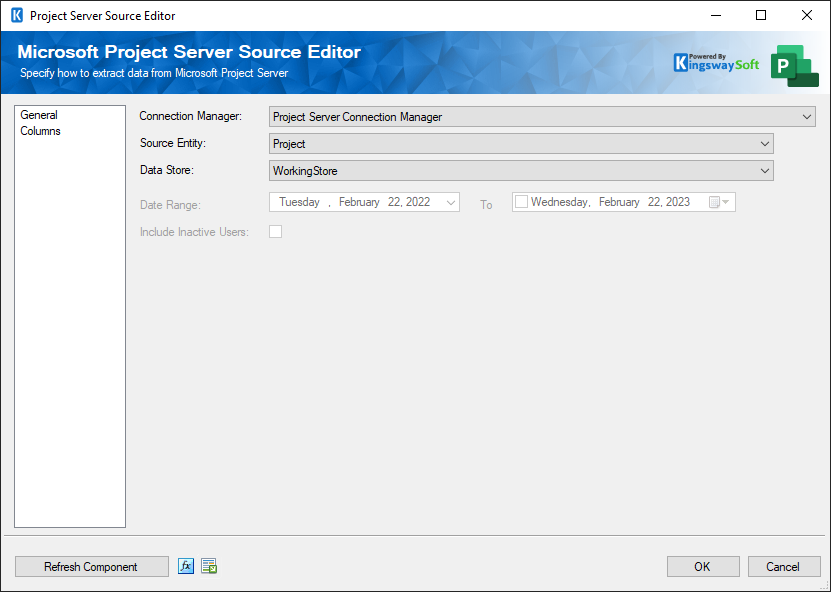
- Connection Manager
-
The Project Server Source Component requires a Project Server connection in order to connect with Microsoft Project Server. The Connection Manager drop-down will show a list of all Project Server connection managers that are available to your current SSIS package.
- Source Entity
-
The Source Entity option specifies a list of Project Server entities from which to retrieve data:
- Resource
- Project
- Task
- Timesheet
- TimesheetAction
- TimesheetLine
- TimesheetLineDetail
- Data Store
-
The Data Store option allows you to specify which data store you are working with when reading data from Microsoft Project Server. The available options include:
- PublishedStore
- VersionsStore
- WorkingStore
- ReportingStore
- PublishedStore
- Refresh Component Button
-
Clicking the Refresh Component button causes the component to retrieve the latest metadata and update each field to its most recent metadata.
Columns Page
The Columns page of the Project Server Source Component shows you all available attributes for the entity that you specified on the General page.
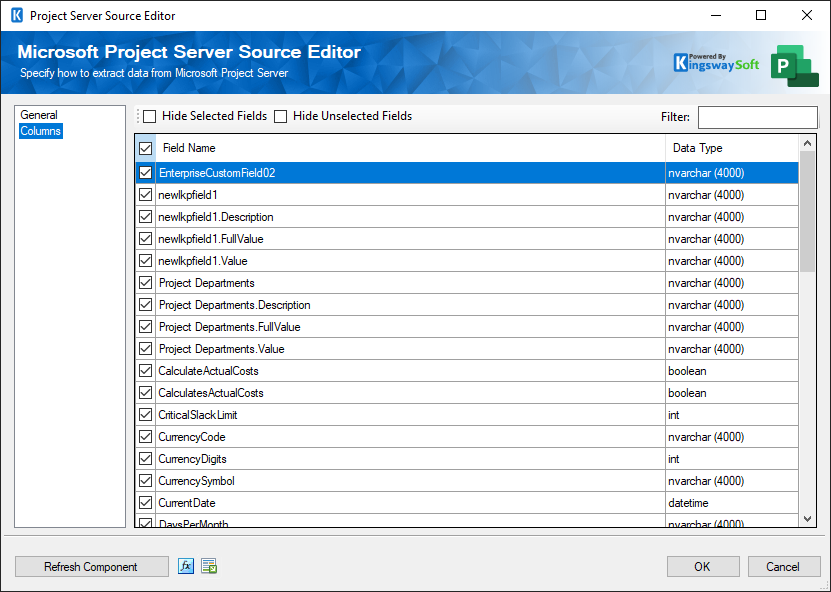
On the top left of the grid, you can see a checkbox, which can be used to toggle the selection of all available Project Server fields. This is a productive way to check or uncheck all available fields.
Note: As a general best practice, you should only select the Project Server fields that are needed for the downstream pipeline components.
Using the Project Server Destination Component
The Project Server Destination Component is an SSIS data flow pipeline component that can be used to write data to Project Server. You can Upsert objects with this component. There are three pages of configuration:
- General
- Columns
- Error Handling
The General page is used to specify general settings for the Project Server Destination Component. The Columns page allows you to map the columns from upstream components to Project Server fields in the destination object. The Error Handling page allows you to specify how errors should be handled when they occur.
General Page
The General page allows you to specify general settings for the component.
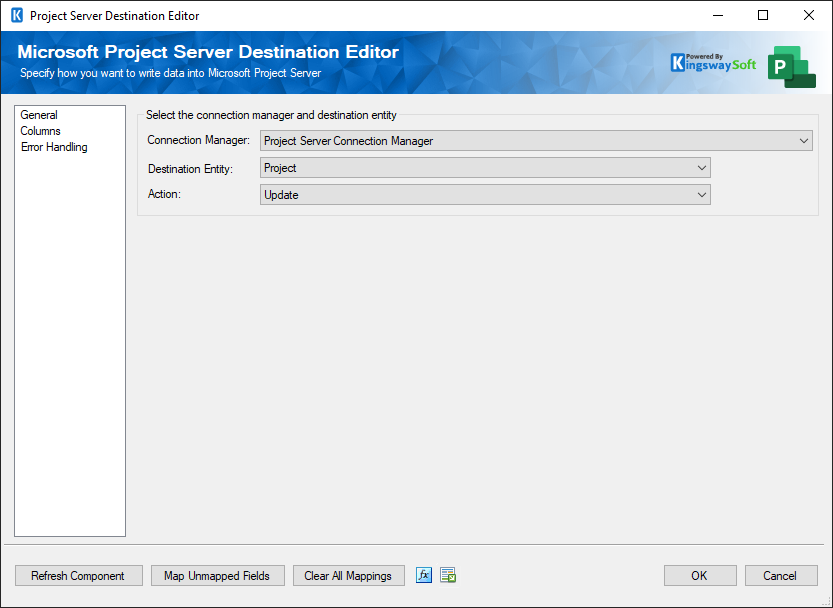
- Project Server Connection Manager
-
The Project Server Destination Component requires a Project Server connection. The Project Connection Manager option will show all Project Manager connection managers that have been created in the current SSIS package or project.
- Destination Entity
-
The Destination Entity allows you to specify the Project Server entity to write to.
- Action
-
The Action option allows you to specify how data should be written to Microsoft Project Server. There are currently five (5) supported:
- Create: Create new record(s)
- Update:Update record(s)
-
Upsert: Update record(s) if the entity exists, otherwise create new record(s).
- Project: PROJ_UID field is required
-
Task:
PROJ_UID and
Id fields are required
- The Id field is the Task's GUID key.
- Resource: RES_UID field is required
- Timesheet: TS_UID field is required
- TimesheetLine: TS_UID and TASK_UID fields are required
- Project: PROJ_UID field is required
- Delete: Delete record(s)
-
Publish: Publish record(s)
- Available with the Project Entity - required field is PROJ_UID
- Refresh Component Button
-
Clicking the Refresh Component button causes the component to retrieve the latest metadata and update each attribute to its most recent metadata.
- Map Unmapped Fields Button
-
By clicking this button, the component will try to map any unmapped Project Server attributes by matching their names with the input columns from upstream components. This is useful when your source component has recently added more columns, in which case you can use this button to automatically establish the association between input columns and unmapped destination attributes.
- Clear All Mappings Button
-
By clicking this button, the component will reset all your mappings in the destination component.
Columns Page
The Columns page of the Project Server Destination Component allows you to map the columns from upstream components to the Project Server destination fields.
In the Columns page, you would see a grid that contains four columns as shown below.
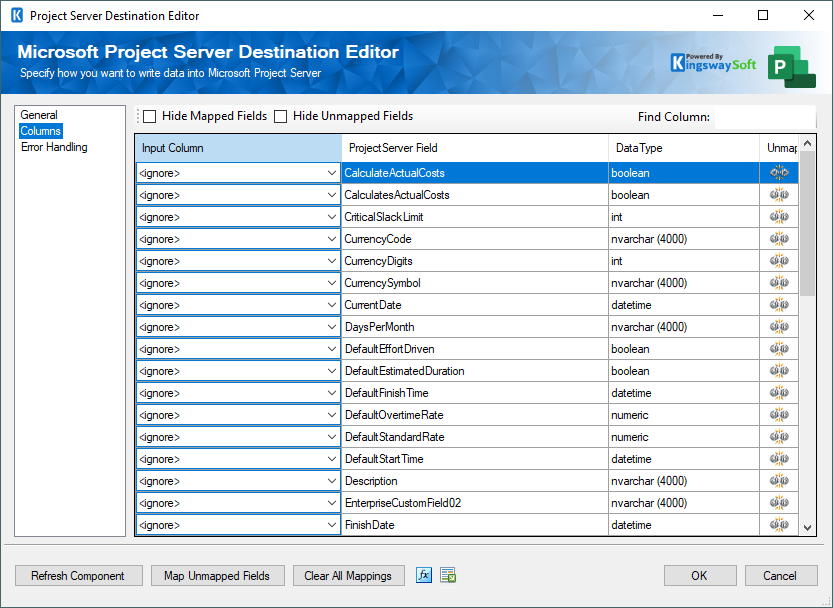
- Input Column: You can select an input column from an upstream component for the corresponding Project Server field.
- ProjectServer Field: The Project Server field where you are writing data.
- Data Type: This column indicates the type of value for the current field.
- Unmap: This column can be used to unmap the field from the upstream input column, or otherwise it can be used to map the field to an upstream input column by matching its name if the field is not currently mapped.
- Implicit Text Lookup
- For system and custom Lookup Fields, you would map the label values to this field. If the Input Column label value does not already exist as an option, the Destination Component will add this value to the field.
Error Handling Page
The Error Handling page allows you to specify how errors should be handled when they happen.
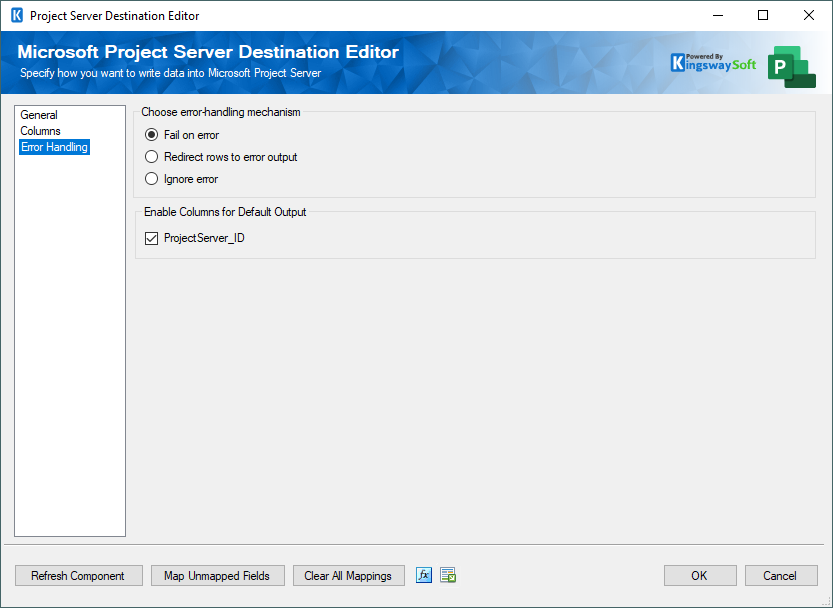
There are three options available:
- Fail on error
- Redirect rows to error output
- Ignore error
When the Redirect rows to error output option is selected, rows that failed to write to Project Server will be redirected to the 'Error Output' output of the Destination Component. As indicated in the screenshot below, the green output connection represents rows that were successfully written, and the red 'Error Output' connection represents erroneous rows. The 'ErrorMessage' output column found in the 'Error Output' may contain the error message that was reported by Project Server or the component itself.
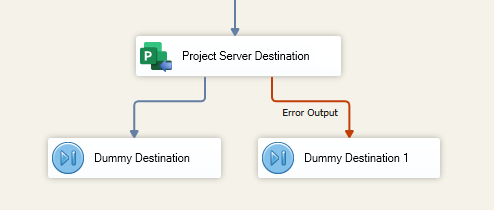
In the Error Output, you can see the following columns:
- ErrorCode: Contains the error code that is reported by Project Server or the component itself
- ErrorColumn: Contains the name of the column that is causing the error. Note that this column is not always populated
- ErrorMessage: Contains the error message that is reported by Project Server or the component itself
Note: Use extra caution when selecting the Ignore error option, since the component will remain silent for any errors that have occurred.
On the Error Handling page, there is also an option that can be used to enable or disable the following output field for the destination component.
- ProjectServer_ID: Contains the newly created Project Server record's ID, which you can use to write to log or further process using additional data flow components.
License Manager
SSIS Integration Toolkit comes with a license manager program that helps you manage and activate the product license key to be used for the toolkit. The below information is useful for development workstations and Single Server license management. For Azure-SSIS IR deployments, license management and activation will be handled through the PowerShell script, see Running SSIS Integration Toolkit on the Cloud for further details.
Without a commercial license, SSIS Integration Toolkit will operate under the Developer License which is free to use for development or evaluation purposes. Under the developer license, you can use the software within the development tool (SSDT-BI, BIDS, or Visual Studio).
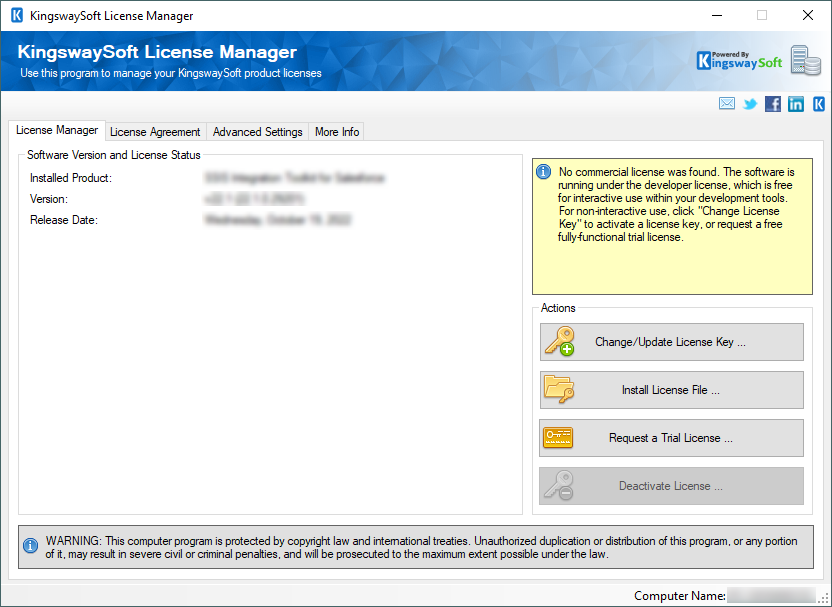
The only limitation of the free developer license is the inability to run the software outside of the development tool (SSDT-BI, BIDS, or Visual Studio). If you would like to run the software outside the development tool, such as running SSIS packages on a scheduled basis or from a command line, you will need to acquire a license from us.
If you want to test out the functionality by scheduling your SSIS packages, a trial license can be requested. To do so, you can launch the License Manager program, then click the "Change License Key" button, where you can request a free trial license after filling out the necessary Licensee Information.
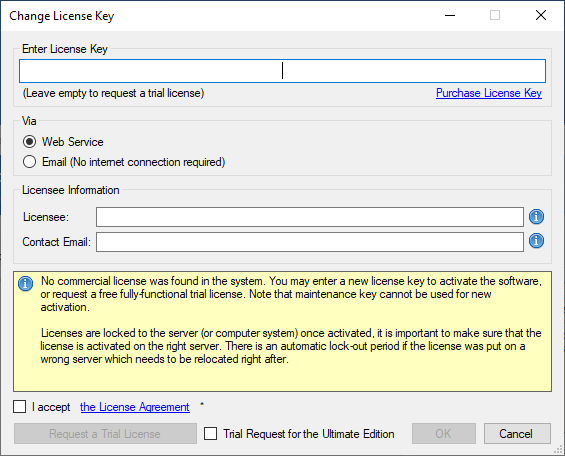
If you have received a product license key from us after placing an order through our online shopping cart system, you can also click the "Change License Key" button and enter the product license key in order to activate the software to use the fully-featured commercial license.
The Licensee field is where you will specify the company the software is licensed to, you can include your system's machine name for future reference. For example, the Licensee can be "ABC Inc." or "XYZ Corp (SQLSVR-001)." The Contact Email would be the person we reach out to for any license-related notices such as renewal reminders.
To request a free trial license or activate a product license key that you have received, you can use the Web Service option to complete the process by sending the request to our license server directly. An Internet connection is required when the Web Service option is used. This is the option that we recommend.
Alternatively, you can choose the Email option so that the license manager will generate an email for you which you can send to us. The Email option should only be used if your system has no Internet access. It requires manual processing so please expect to wait for 24 to 48 hours before receiving a license file from us. Once you have received the license file from us through email, you can save it to a local file, which you can then install by clicking the "Install License File..." button in the License Manager.
If you have acquired a license from us, once the software has been activated, your license manager will be shown as below:
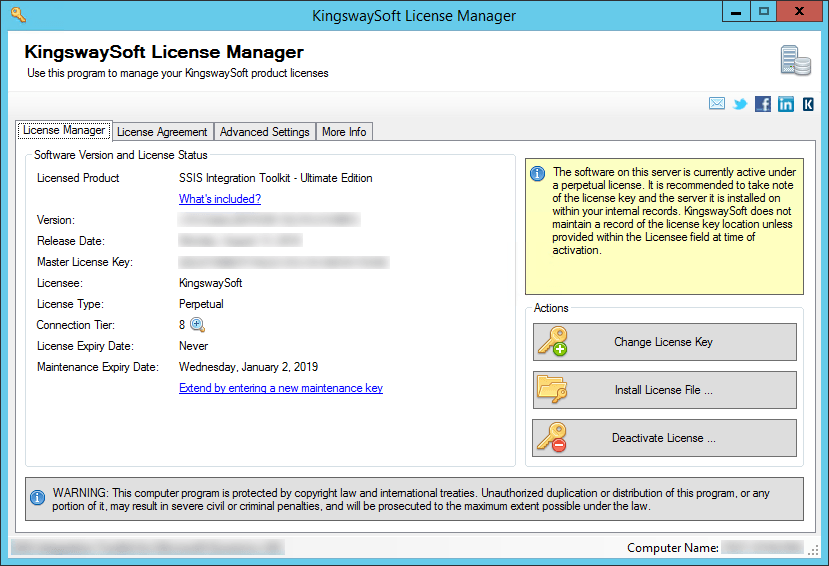
Connection Tier will display the number of distinct connections your license supports per connection type within a 24-hour period at run-time. Multiple connections to the same instance are typically treated as 1 distinct connection (exceptions may apply depending on the nature of the service). Selecting the magnify icon will launch the Run-time Connection Usage Summary window which will display counts on the number of connections made per connection type and when the 24-hour period will reset.
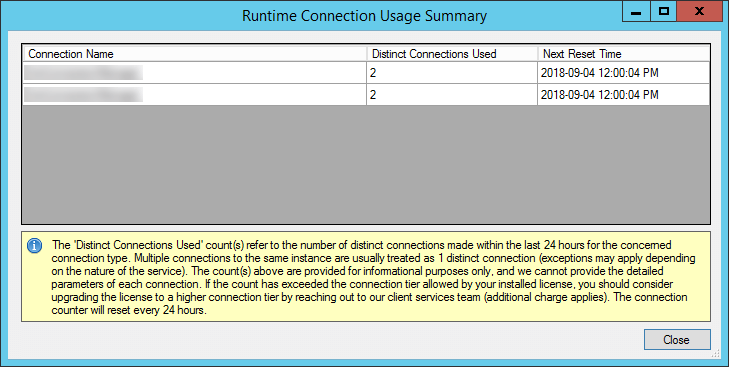
You can see your Maintenance Expiry Date in the License Manager program if you are using a perpetual license. By default, your perpetual license comes with a one-year maintenance and upgrade, which entitles you to use any version of the software released before your Maintenance Expiry Date. You can extend it by entering a new maintenance license key that you have acquired from us.
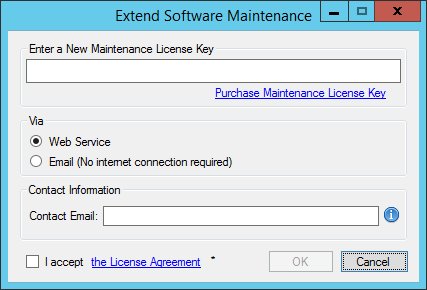
If your commercial license is a subscription license, you will not see the Maintenance Expiry Date option in the License Manager program, since your subscription license comes with maintenance and upgrade for the entire subscription period. Instead, you will see your license expiry date and a progress bar with the number of days left on your subscription.
Note: You must run the License Manager program under a local administrative account due to the privileges required to write license files to the system.


